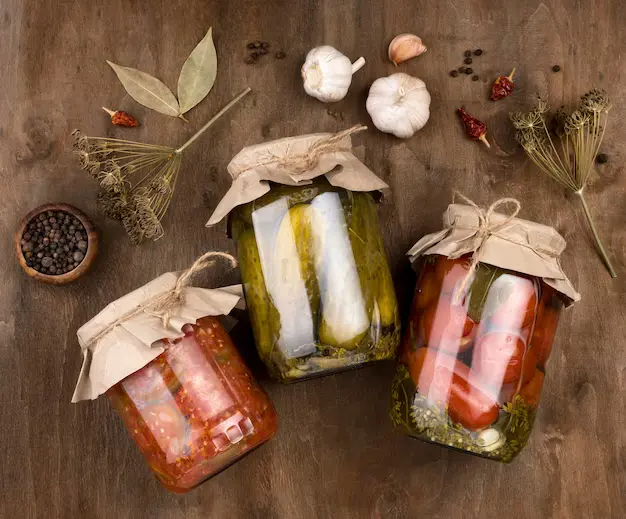Pickles industry (pickles – Turkey – Middle East) are mostly vegetables preserved in a solution of vinegar, salt, and other flavors. It is usually fermented with naturally occurring bacteria before the vinegar can be preserved.
While the technique of making pickles in Turkey and the Middle East has been known since ancient times, pickles are still a popular food, with more than 5 million pounds (2.27 million kg) consumed daily.

Table of Contents
History of pickles industry – Turkey – Middle East
Pickling plant and animal foods is a relatively old way of preserving food. It is estimated that the first pickles were produced over 4,000 years ago using cucumbers native to India. Both the ancient Egyptians and the Greeks wrote about the use of pickles for their nutritional value and healing powers. Pickles were a popular food during the time of the Roman Empire and quickly spread across Europe. In America, pickles have always been popular. Early travelers to America kept pickles in large quantities because they were nutritious and did not spoil during long journeys. The first large-scale commercial production of pickles did not take place until 1820, when Nicolas Appert began selling pickles in jars. Over the years, the pickle production process has become more automated, and the pickle industry has developed in Turkey and the Middle East. However, the basic pickling methods have not changed much since the technology was first developed.
While there are many different types of pickles, there are some characteristics common to all. In general, pickled cucumbers are crunchy vegetables that can be described as having a strong, pungent flavor caused by the vinegar in which they were stored. Different pickle manufacturers usually add spices to give the pickles a unique flavor. Dill-flavored pickles are perhaps the most popular of all pickles. There are also sweet pickles that are full of added sugar. These are commonly used to make relishes. But the word kosher is now used to describe any garlic-flavored pickle.
Raw materials for pickles industry – Turkey – Middle East
There are six basic types of ingredients used to make pickles. The main bulk food is vegetables. Additional ingredients include acids, flavorings, colorings, preservatives, and stabilizers that make up the liquid or liquid in which the pickle is sold. Many ingredients are only available at certain times of the year, so steps must be taken to use the freshest materials.

There is no doubt that the most important ingredient in making pickles is cucumber. The special seeds are used to produce cucumbers that are straight, thin-skinned, have an expected number of warts, and are of adequate size. These properties are important for uniformly manufacturing pickles. Technically, pickles can be made using all kinds of foods like onions, peppers, olives, pears, peaches, and even fish and meat. These foods are commonly referred to as pickled foods to indicate the type of processing required to make them.
Acetic acid (vinegar) is the primary ingredient used in the manufacture of pickles. After water, it makes up the bulk of the pickling liquid and contributes significantly to the flavor of the pickle giving it a sour taste. In addition, it also has a protective effect and is non-toxic. Vinegar is derived from natural sugars or starches through a two-step fermentation process. The starch is converted into sugar, and then the yeast is fermented to form alcohol. Alcohol is exposed to aceto bacteria, which turns it into vinegar. Vinegar can be obtained from several sources and each has a slightly different taste. Therefore, depending on its source, vinegar can have a significant impact on the taste of the final pickled product.
Other ingredients, which affect the final taste of the pickles, are added to the liquor. Sugar is used to provide sweetness to offset the sour taste of vinegar. It also helps make pickles more crunchy and firm. Artificial sweeteners such as aspartame and saccharin can be used to get a similar effect without adding calories. Salt is added for flavor and also has an additional preservative effect. Pure granular salt is usually used because it is devoid of anti-caking ingredients that can make the liquid cloudy.
While vinegar, sugar, and salt make up the bulk of all pickle liquids, it’s the different spices and herbs that differentiate the types of pickles. The dill herb is the most popular of aromatic spice and is used to make all forms of dill pickles. Other aromatic spices include allspice, cinnamon, cinnamon, cloves, fennel, fenugreek, and nutmeg. For more robust pickles, hot spices such as black pepper, black pepper, ginger, and mustard are used. Herbs such as basil, marjoram, mint, tarragon, and thyme are also used to give pickles a unique taste. Savory vegetables including onions and garlic are often included in a pickled drink. Typically, a pickle manufacturer will have a standard seasoning blend made for each type of pickle they make.

Some additional ingredients may be added to ensure that the pickles meet the standards set by the manufacturer. In general, pickles do not require any colorings because their natural color is acceptable. However, to create a uniform product and overcome the effects of processes such as bleaching, manufacturers often add color. Two common colorants are turmeric, caramel, and chlorophyll. Caramel gives a brown to slightly yellow color and chlorophyll gives a green color. To prevent color changes in pickles, sulfur dioxide is added. Stabilizing agents such as lime and alum may also be added. These substances help make the pickles crunchy without affecting the flavor. Surfactants such as polysorbate are also used to bind ingredients in a liquor solution.
Pickles manufacturing process – Turkey – Middle East ( pickles industry )
Cucumber pickles can take up to 42 days to make, depending on the manufacturer’s recipe. Production involves four basic steps which include harvesting, preservation, pasteurization and final processing. The process is highly automated once the cucumbers are delivered to the processing plant.
Harvest to pickles industry
- 1 Once harvested by field workers, the cucumbers are placed in large crates and transported to a receiving station. If the cucumbers are transported a long distance
Preservation to pickles industry
- 2 Depending on the manufacturer, cucumbers can be made into a pickle in one of three ways including fermentation, pasteurization, and refrigeration. The first and oldest method is a process known as fermentation. In this method, cucumbers are transferred to large, sealed fiberglass or stainless steel tanks. Some of these containers can hold more than 40,000 pounds (18,160 kg) of cucumbers. The tanks are filled with brine consisting of water and 10% salt. The manufacturer can take

- During the storage period of about five weeks, fermentation bacteria break down the sugars in the vegetables and produce carbon dioxide. To prevent the harmful effects of carbon dioxide, the tanks are emptied periodically. Pickles made in this way have a shelf life of several months.
Processing and packaging pickles – Turkey – Middle East
- 3 After the pickles have fermented enough, the brine is drained off. The pickles are then immersed in water to remove all the salt they may have acquired during the treatment. From this point, the pickles are conveyed along a conveyor to a shredder that cuts the pickles to the correct size depending on the type of product required.
- 4 After chopping, the pickles are usually placed in glass containers although cans, plastic bottles, and bags are also used. Filling machines are designed to deliver the correct amount of vegetables to each jar.
Pasteurization and sealing
- 5 The problem of spoilage is evident during the pickle-making process. Cucumbers can spoil during the fermentation process and even during packaging if they are exposed to air for too long. For this reason, pickles are pasteurized.

- 6 Most pickles are vacuum-packed, which means the air is removed from the jar before it is sealed. This helps preserve the taste of the pickle and prevents contamination by microorganisms. In order to vacuum pack pickles, the air in the jar is replaced by steam just before the lid is closed. As the vapor cools and condenses, it creates a vacuum, which reduces the amount of free oxygen in the jar. The vacuum seal is responsible for the familiar pop heard when the pickles jar is opened.
Quality control of pickles – Turkey – Middle East
Quality control is an important part of any food preparation process. It is especially important in making pickles because poor quality control will result in an unpalatable product. The process begins in the field while the cucumbers are being harvested. Trained workers check the cucumbers for any signs of spoilage. If any rotten option is found, it is discarded. Most manufacturers set specifications that an option must meet before use. during production,

The future of pickles – Turkey – Middle East
The research focused on improvements in pickle technology is being conducted by various seed companies and universities. One major area of interest is the development of improved pickling cucumbers. NanoPro Consulting in food processing is concerned with the latest developments and cost reduction with high quality and longer life


